Key takeaways
- Crème brûlée’s luxurious texture comes from the contrast between silky custard and a hard caramelized sugar top, which requires patience and careful technique.
- Using high-quality ingredients, such as fresh eggs and real vanilla beans, significantly enhances the flavor and texture of the dessert.
- Mastering the steps of tempering eggs, employing a water bath, and caramelizing sugar with control are essential for achieving a perfect crème brûlée.
- Allowing the custard to chill thoroughly and caramelizing the sugar just before serving preserves the fresh taste and satisfying crack of the topping.
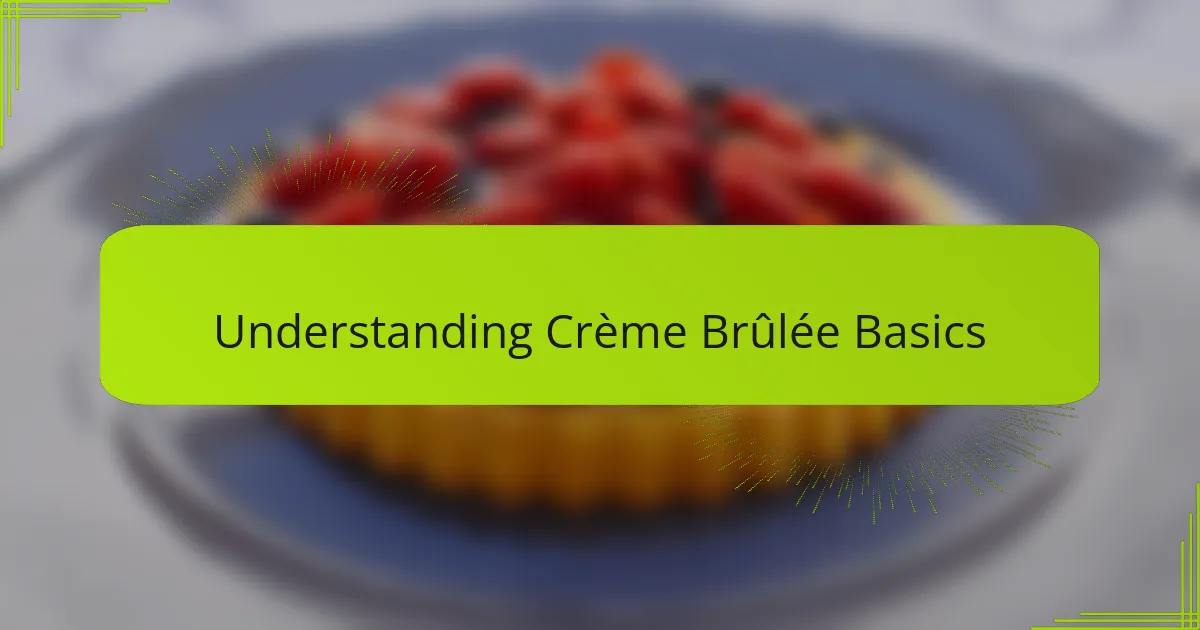
Understanding Crème Brûlée Basics
At its core, crème brûlée is beautifully simple: a rich custard base topped with a layer of hard caramelized sugar. But have you ever wondered why this dessert feels so luxurious? I think it’s the contrast—the creamy softness beneath that crackling, caramel shell—that makes every bite feel like a little celebration.
When I first attempted to master crème brûlée, I was intimidated by the custard’s delicate texture. How do you get it silky smooth without curdling or drying out? It turns out, patience and gentle heat are key, and understanding this balance transformed my approach entirely.
Caramelizing the sugar on top might seem straightforward, but achieving that perfect golden crust requires practice. Have you noticed how a torch or broiler can produce dramatically different results? From my experience, knowing your tools and timing instinctively is what truly sets a great crème brûlée apart.
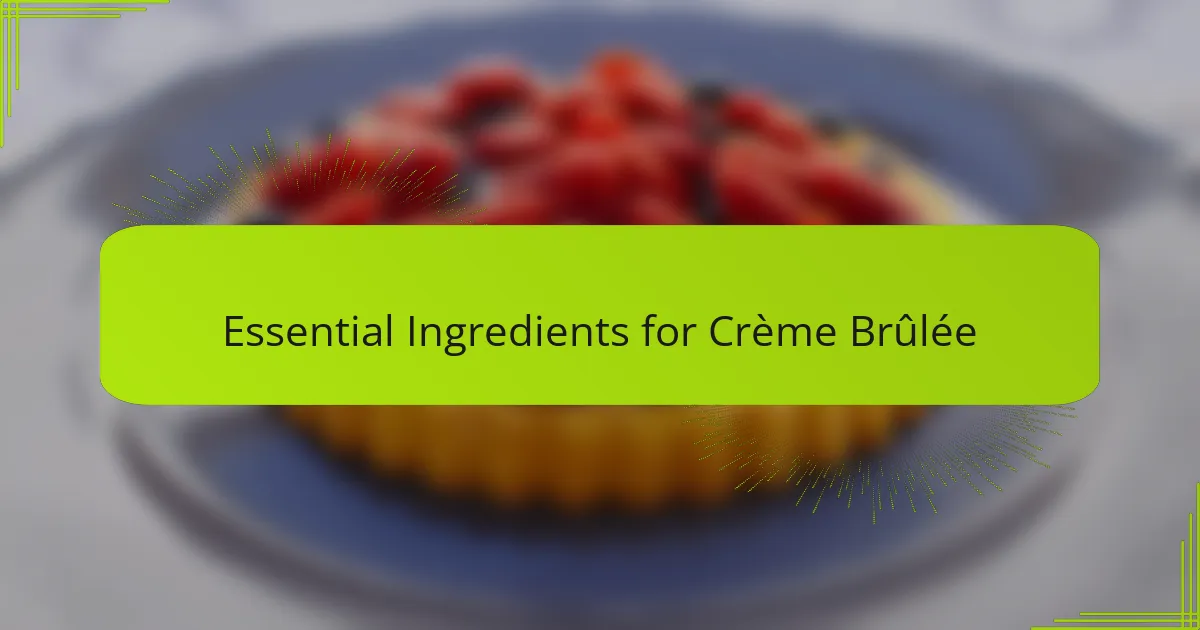
Essential Ingredients for Crème Brûlée
The magic of crème brûlée starts with its ingredients, and honestly, I believe choosing the right ones can make or break the whole experience. Eggs, heavy cream, sugar, and vanilla—each plays a crucial role in creating that smooth custard and perfectly caramelized top. Have you ever noticed how fresh eggs with vibrant yolks seem to give your custard a deeper, richer color? In my kitchen, I always opt for the freshest eggs I can find; it just feels like they bring the custard to life.
Vanilla is another ingredient where quality really shines through. I used to think vanilla extract was enough until I experimented with real vanilla beans. The little black seeds and that intoxicating aroma elevate the flavor to a whole new level—it’s like a secret whisper of luxury in every bite. And sugar? Not all sugars caramelize the same way. I’ve found that fine granulated sugar melts evenly and gives that crisp, glassy topping that cracks just right; coarser sugars tend to burn too quickly or stay grainy.
Finally, the cream’s richness is what rounds out the custard’s texture. Full-fat cream is non-negotiable for me. It contributes that velvety mouthfeel that makes crème brûlée feel indulgent rather than just sweet. Have you ever tried to cut corners with lighter cream and ended up with a watery custard? I learned the hard way that patience in sourcing these ingredients really pays off in the final product.

Step by Step Crème Brûlée Recipe
Getting the custard just right starts with tempering your eggs carefully—slowly whisking hot cream into beaten eggs prevents scrambling, which was a game changer for me. Have you ever dumped hot liquid straight into eggs and ended up with little curdled bits? I have, more times than I’d like to admit, but once I mastered this gentle warming technique, my custard was silky smooth every time.
Once your custard mixture is ready, pouring it into ramekins and baking in a water bath is crucial. I remember the first time I forgot the water bath and ended up with cracked, uneven custards—it felt like a disaster! That gentle, even heat from the water bath keeps the custard from overheating and drying out, giving it that luscious, creamy texture I aim for.
Finally, achieving that iconic caramel crack is all about timing and technique. I’ve played with both a kitchen torch and broiler, but nothing beats the control of a torch in my opinion. Slowly moving the flame over the sugar until it melts and deepens to a golden brown feels almost meditative—plus, the instant crunch when you tap the hardened top is so satisfying. Have you tried slowly caramelizing sugar? The transformation feels like magic right in your own kitchen.
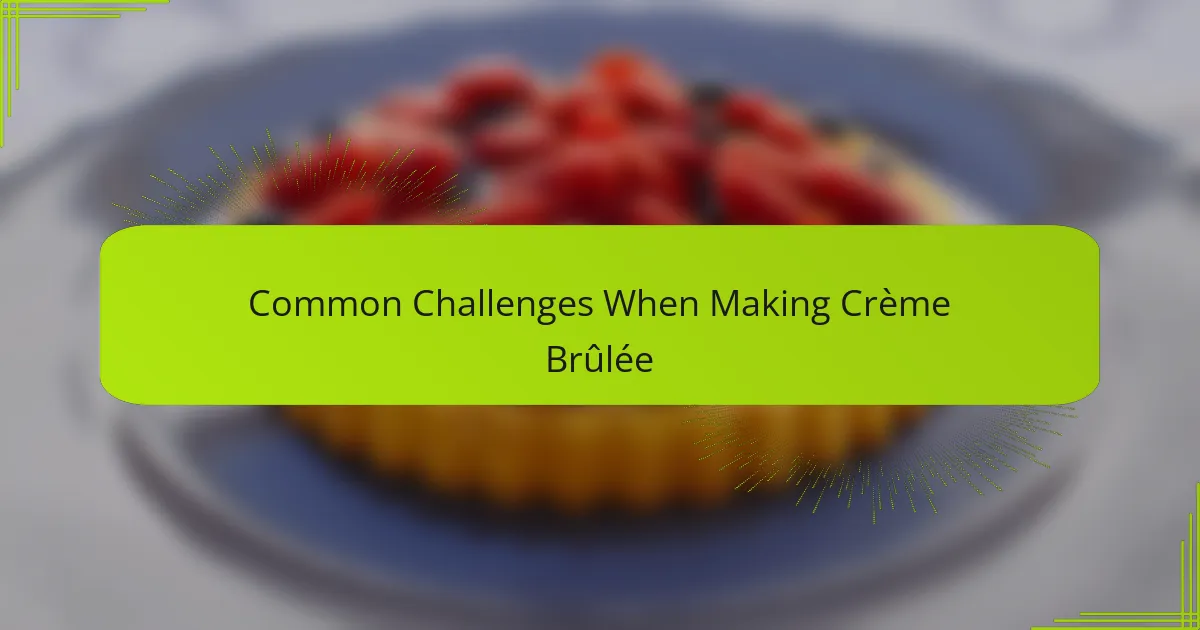
Common Challenges When Making Crème Brûlée
One of the trickiest hurdles I faced when making crème brûlée was preventing the custard from curdling. It’s so tempting to rush the process, but if the eggs get too hot too quickly, you end up with a grainy texture instead of that silky smoothness I crave. Have you ever been excited to taste your creation only to discover it’s more scrambled eggs than dessert? That disappointment pushed me to slow down and embrace gentle, patient warming.
Another challenge that caught me off guard is the water bath. I learned the hard way that skipping it or not having enough water can cause the custards to bake unevenly or worse, crack. Watching those delicate ramekins bounce in their hot water bath feels almost like a balancing act—and for good reason. I now check and refill the water mid-bake, ensuring each custard cooks evenly and stays perfectly creamy.
Then there’s the caramelizing step—getting that sugar top just right is an art in itself. I remember my first attempt using a broiler, nervously watching as the sugar either barely melted or quickly burnt black. It made me realize how important knowing your tools is. Using a kitchen torch gave me that control and confidence, letting me slowly coax the sugar into a crispy, golden shell that cracks just the way I imagined. Have you tried that satisfying tap of the caramel crust? It’s honestly one of the most rewarding moments in making crème brûlée.
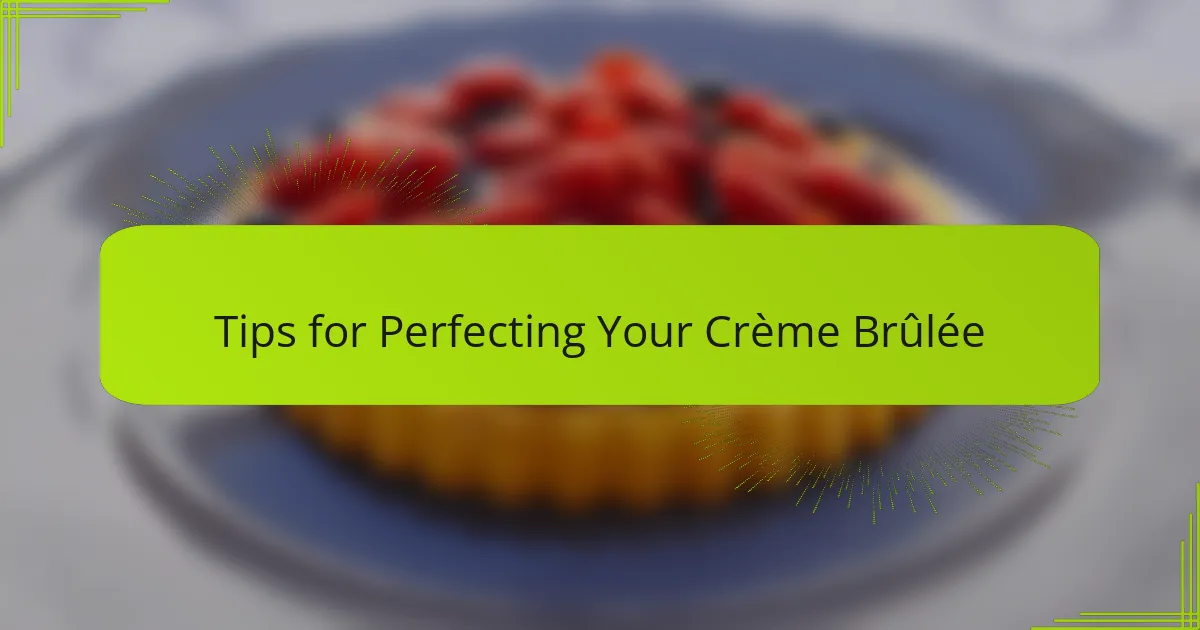
Tips for Perfecting Your Crème Brûlée
One tip that transformed my crème brûlée was to always strain the custard mixture before baking. At first, I thought it was an unnecessary extra step, but after catching tiny bits of cooked egg, I realized how much smoother the custard became. Have you tried this? The silky texture afterward feels absolutely worth those few seconds.
Another trick I swear by is chilling the custard thoroughly—overnight if possible. I used to rush straight to caramelizing the sugar, but that led to a soupy top or a crust that didn’t set right. Waiting gave the custard a chance to firm up just enough, making that satisfying crack when you tap the caramel truly satisfying.
Finally, when caramelizing, patience is key. I often remind myself not to blast the sugar all at once with the torch. Instead, I slowly move the flame, watching the sugar gently melt and change color. Do you notice how this careful approach creates an even, golden crust? That moment when the sugar hardens and you hear that crisp crack is pure dessert magic.
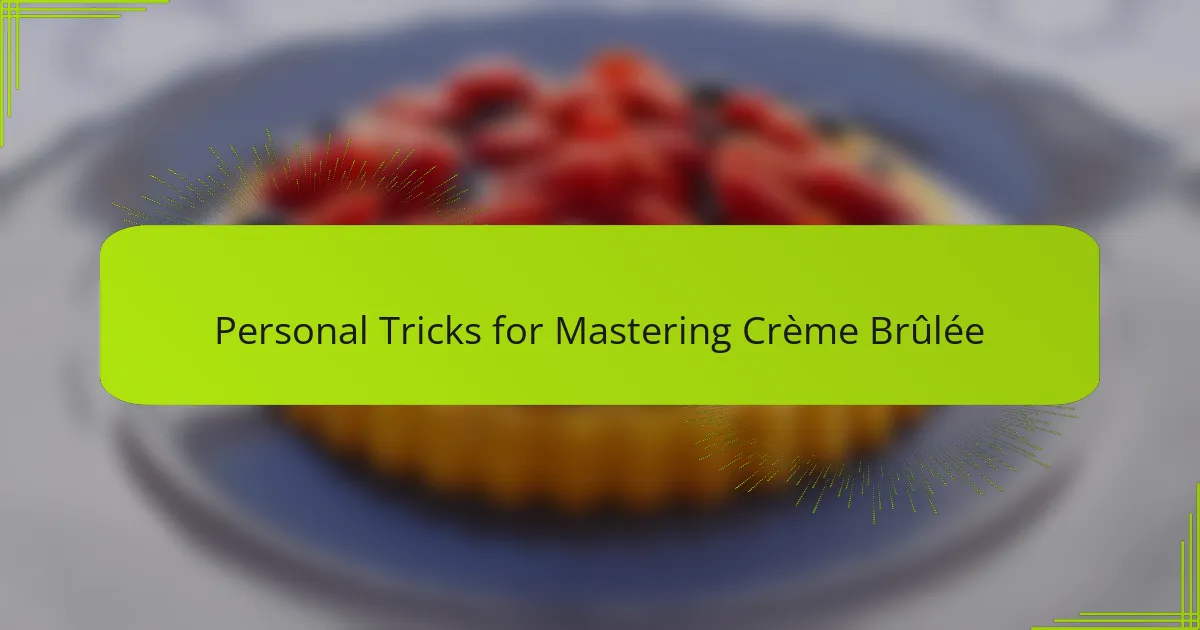
Personal Tricks for Mastering Crème Brûlée
When I started mastering crème brûlée, one of my go-to tricks was to let the custard rest in the fridge for at least 12 hours. Have you ever noticed how chilling helps the flavors meld and the texture become impossibly smooth? That quiet waiting period turned out to be a game changer for me—each bite felt richer and more indulgent.
Another thing I learned is to caramelize the sugar slowly and patiently. I used to get so excited that I’d blast the top with the torch, only to end up with uneven charred spots. Slowing down and moving the flame in gentle circles created a uniform, glossy crust that cracks perfectly on the first tap. It’s a small ritual, but one that makes me feel connected to the dessert—almost like painting a masterpiece.
Lastly, I’ve found that using a thin layer of sugar works best. Too thick, and the sugar takes forever to melt; too thin, and the crunch disappears too quickly. Have you ever experimented with this? Finding that perfect balance was like discovering a secret code for crème brûlée perfection, one I now swear by every time I make it.
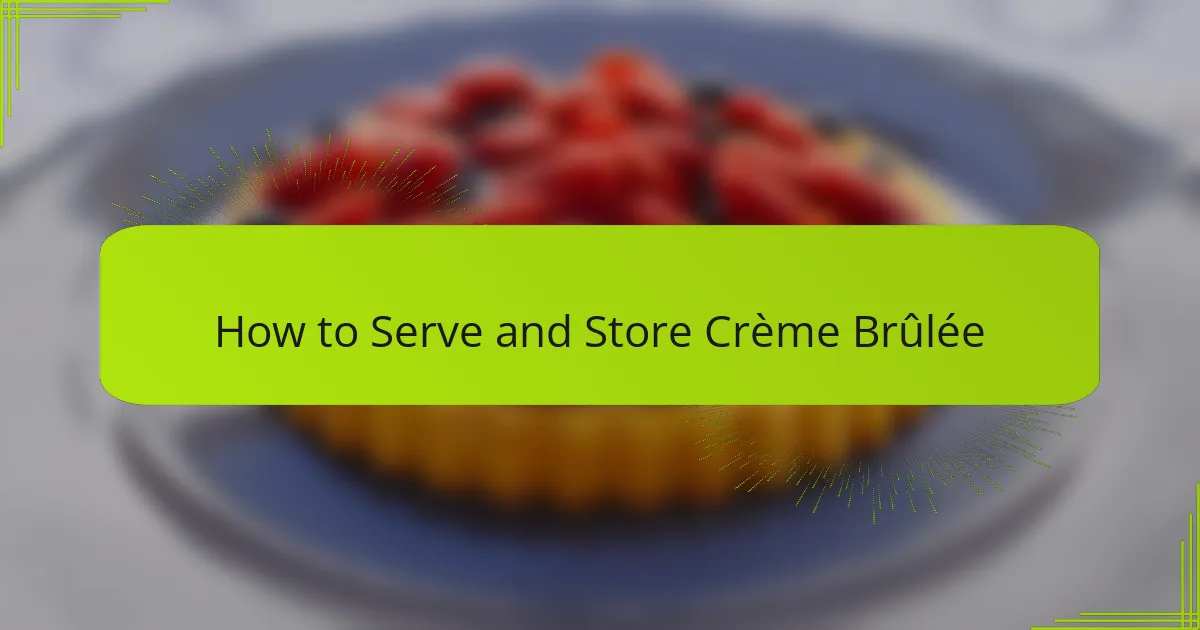
How to Serve and Store Crème Brûlée
Serving crème brûlée is where the magic truly unfolds. I love bringing out the ramekins straight from the fridge and immediately caramelizing the sugar, so the contrast between cold custard and warm, crackling top feels as dramatic as possible. Have you tried serving it right after torching the sugar? That first crisp crack under your spoon always feels like a small, celebratory moment worth savoring.
When it comes to storing crème brûlée, I learned the hard way that skipping refrigeration leads to disappointing results. After my first batch sat out too long, the custard lost its delicate texture and the caramel started to soften. I now keep leftover crème brûlée covered tightly in the fridge, and it stays fresh for up to two days. Have you noticed how the sugar crust can soften overnight? Resurfacing it with a quick torching before serving can revive that signature crack and crispness beautifully.
For those wondering about prepping crème brûlée ahead of time, chilling is key, but so is timing your caramelizing. From my experience, it’s best to wait to brûlée the sugar just before serving, rather than caramelizing days in advance. The crust tastes fresher and cracks so satisfyingly, making every bite feel like it was made just for you in that moment. Doesn’t that fresh crack sound worth the extra minute?




